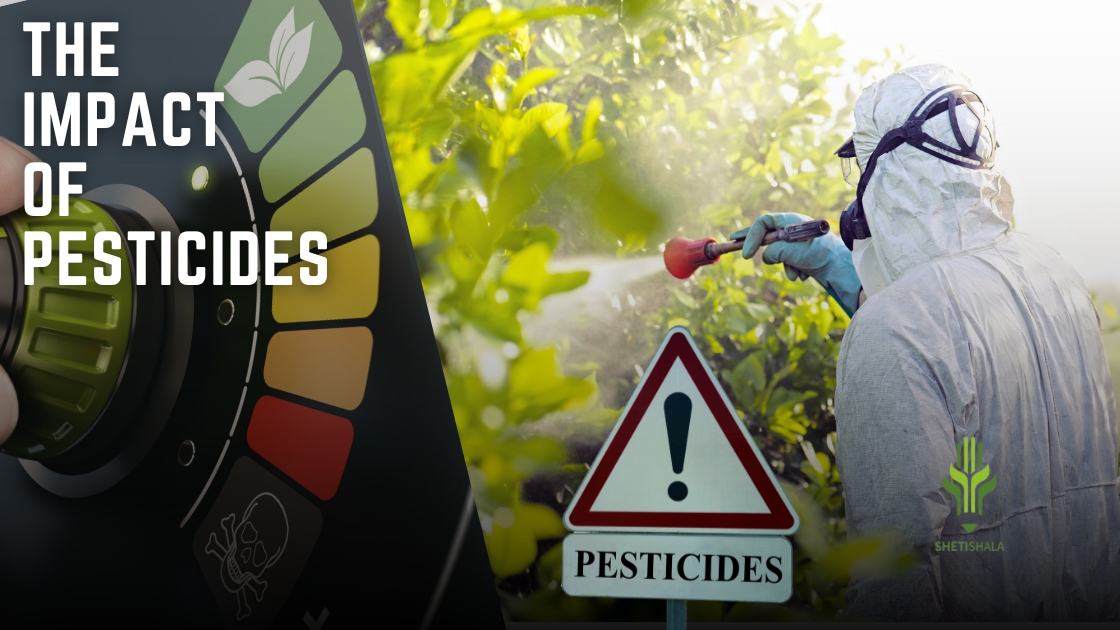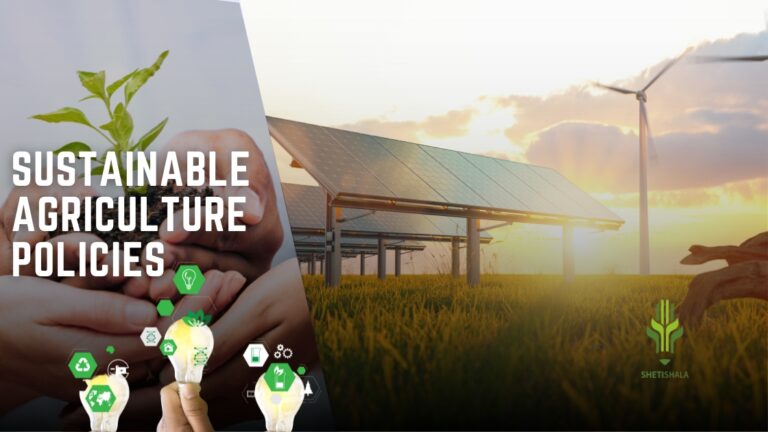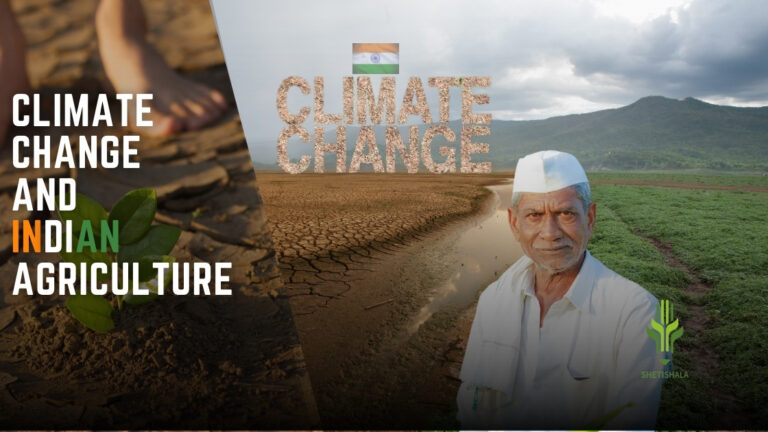Introduction
Explore the impact of pesticides in agriculture through our insightful blog. We examine both the positive impact of pesticides, such as enhanced growth conditions and improved soil fertility, and nutrient cycling. Learn how pesticides contribute to nutrient availability in crops while also addressing the challenges they present, including the causes of pesticide resistance. This blog provides a balanced perspective on the role of pesticides in modern farming, highlighting their benefits and the environmental concerns they raise. Stay informed on how pesticides affect crop production and the broader ecosystem.
Pesticides are substances used to prevent, destroy, or control pests, including insects, weeds, fungi, and other organisms that can harm crops. They play a crucial role ni modern agriculture by helping to increase food production and improve crop quality. However, their use also has significant
environmental and health implications.
What is pesticides ?
Pesticides are substances or mixture of substances used to control, repel, or kill pests, including insects, rodents, fungi, bacteria, and weeds. They are widely used in agriculture, homes, gardens, and public spaces to manage pests and maintain
ecosystem balance.
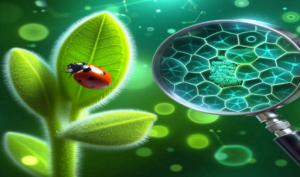
Types of pesticides include .
1 Insecticides
2. Herbicides
3. Fungicides
4. Rodenticides
5. Bactericides
Pesticides can be classified as: .
1 Chemical pesticides
2. Biological pesticides
3. Cultural control
4. Physical controls
While pesticides have benefits, their misuse or overuse can lead to environmental and
concerns, such as pollution, toxicity, and resistance. Integrated Pest Management (IPM) strategies aim to minimize pesticide use and promote sustainable practices.
Positive Impact of pesticide
1. Increased crop yeild
1. Insecticides:
Insecticides target harmful insects that feed on crops. By controlling insect populations, they prevent damage to crops, which can result ni higher yields.
2. Herbicides:
Herbicides manage weeds that compete with crops for nutrients, water, and sunlight. Effective weed control ensures that crops have better access to these resources, promoting healthier and more robust growth.
3. Fungicides:
Fungicides protect crops from fungal infections, which can devastate entire fields fi left unchecked. By preventing or treating fungal diseases, fungicides help maintain healthy crops.

2. Reduced Crop Losses
1. Prevention of Diseases:
Pesticides can prevent the onset of diseases that can decimate crops. By keeping diseases at bay, crops can grow without being stunted or killed by pathogens.
2 . Minimized Physical Damage:
Insect pests can cause physical damage to crops, leading to reduced photosynthesis and poor growth. Controlling these pests helps maintain the structural integrity of plants, supporting better yields.
3. Enhanced Efficiency
1. Less competition
By controlling weeds, herbicides reduce competition for essential resources like nutrients, water, and light. This allows crops to grow more efficiently and produce higher yields.
2. Resource Allocation:
Farmers can allocate resources more effectively when pest pressure is minimized. For example,
irrigation and fertilization can be more efficiently used on healthy crops, maximizing yield potential.
4. Economic Benefits
1 . Higher Returns:
Increased yields result in higher economic returns for farmers. This can lead to reinvestment in better farming practices and technologies, further boosting productivity.
2. Stability and Predictability:
Effective pest control through pesticides can make crop yields more stable and predictable, which is crucial for food supply chains and market stability.
5. Technological Integration
1. Precision Agriculture:
Modern farming techniques, such as precision agriculture, use advanced technologies to apply pesticides more accurately and efficiently. This minimizes waste and maximizes the positive impact on crop yields.
2. Genetically Modified Crops:
Some genetically modified crops are designed to be resistant to certain pests, reducing the need for chemical pesticides and promoting better yields.
Improved Crop Quality
1. Protection from Insect Damage Insecticides:
Prevent insects from feeding on crops, which can cause physical damage and reduce the visual appeal of produce.
Protect crops from insect-borne diseases that can compromise the quality and safety of the produce.
2. Disease Control Fungicides:
Control fungal infections that can cause blemishes, rotting, and other quality issues in crops.
Maintain the health of crops by preventing diseases that can affect their taste, texture, and overall quality.
Bactericides:
Protect crops from bacterial infections that can lead to spoilage and reduce shelf life.
Ensure that produce remains safe for consumption by eliminating harmful bacteria.
3. Weed Management
Herbicides:
Reduce competition from weeds, ensuring that crops receive adequate nutrients, water, and light.
Promote uniform growth and development, leading to more consistent and higher-quality produce.
4. Aesthetic and Marketability
Prevention of Physical Damage:
Protect crops from pests that cause visible damage, such as holes ni leaves or fruit, which can reduce marketability.
Maintain the visual appeal of produce, which is important for consumer preference and market value.
Enhanced Growth Conditions

Healthier Plants:
By controlling pests and diseases, pesticides help plants grow more robustly, resulting in produce with better size, color, and nutritional content.
Healthy plants are more resilient to environmental stresses, leading to higher quality yields.
6. Extended Shelf Life
Post-Harvest Protection:
Pesticides can protect crops during storage and transportation, reducing post-harvest losses and maintaining quality until they reach consumers.
Prevent spoilage and decay caused by pests and diseases, ensuring longer shelf life and fresher produce.
3. Economic Benefits
1. Cost Savings
Reduced Crop Losses:
Effective pest management prevents significant crop losses due to pest infestations and diseases, ensuring that more of the planted crops reach harvest and can be sold.
Lower Labour Costs:
The use of pesticides can reduce the need for manual labour in controlling pests and weeds. This saves labour costs and allows farmers to allocate resources more efficiently.
2. Stable and Predictable Yields
Risk Mitigation:
Pesticides help stabilize crop production by mitigating the risks posed by pests and diseases. This stability allows farmers to plan and manage their operations more effectively, ensuring a reliable income stream.
Supply Chain Reliability:
Consistent crop yields contribute to astable food supply chain, benefiting both producers and consumers. This reliability is crucial for market stability and food
security.
3. Enhanced Competitiveness
Global Market Access:
Farmers using pesticides to produce high-quality, high-yield crops can compete more effectively in
global markets. Meeting international quality standards opens up export opportunities and access to broader markets.
Price Competitiveness:
Higher productivity and quality can lead to economies of scale, enabling farmers to offer competitive prices while maintaining profitability.
4. Technological Advancements
Innovation and investment
The economic benefits derived from pesticide use can encourage investment in new technologies and farming practices. Innovations ni precision agriculture and integrated pest management (IPM) can further enhance productivity and sustainability.
5. Economic Growth
Agricultural Sector Development:
The overall economic health of the agricultural sector is bolstered by the benefits of pesticide use. Increased farmer incomes can lead to investment in infrastructure, education, and community development.
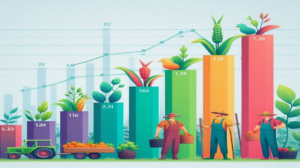
Reduced Labour Costs:
1. Decreased Need for Manual Weeding
Herbicides:
Herbicides control weed growth, eliminating the need for manual or mechanical weeding.
reduction in manual labour not only saves time but also reduces the number of workers required for this task, leading to significant cost savings.
2. Simplified Pest Management
Insecticides and Fungicides:
Pesticides effectively control insect pests and fungal diseases, reducing the need for manual monitoring and intervention. This streamlines pest management processes and decreases the labor required for inspecting and treating crops.
3. Efficient Use of Resources
Precision Application:
Advanced pesticide application technologies, such as precision spraying, ensure that pesticides are applied efficiently and only where needed. This reduces the amount of pesticide used and the labor involved in application.
4. Time Savings Faster Control Measures:
Pesticides provide quick and effective control of pests and diseases compared to manual methods. This allows farmers to save time and redirect labour to other important farming activities, enhancing overall farm productivity.
5. Reduced Need for Repeated Applications
Long-lasting Effects:
Many modern pesticides have long-lasting effects, reducing the frequency of applications required. This decreases the labour needed for multiple rounds of treatment throughout
the growing season.
6. Lower Maintenance Requirements
Less Crop Damage:
By preventing pest and disease damage, pesticides reduce the need for labour-intensive crop
maintenance and repair. Healthy crops require less intervention, saving labour costs associated with managing damaged plants.
Negative Impacts:
1. Environmental Damage:
1.Water Contamination Surface Water Pollution:
Pesticides can runoff from agricultural fields into nearby rivers, lakes, and streams, contaminating these water bodies. This can harm aquatic life, disrupt ecosystems, and affect water quality.
Groundwater Contamination:
Pesticides can leach through the soil into groundwater, posing risks to drinking water sources. Contaminated groundwater can affect human health and the environment.
2. Soil Degradation
Soil Health Impact:
Pesticides can harm beneficial soil microorganisms that are crucial for nutrient cycling and maintaining soil health. This can lead to reduced soil fertility and structure overtime.
Chemical Residues:
Persistent pesticides can accumulate ni the soil, leading to long-term contamination and potentially impacting future crops and plant health.
3. Non-target Species Harm Beneficial Insects:
Pesticides often kill non-target beneficial insects, such as pollinators (bees, butterflies) and natural pest predators (ladybugs, spiders). This can disrupt pollination processes and natural pest control.
Wildlife Poisoning:
Pesticides can poison birds, mammals, and other wildlife either directly through ingestion or indirectly through the food chain. This can lead to population declines and biodiversity loss.
4. Ecosystem Disruption Food Chain Effects:
The accumulation of pesticides in organisms can move up the food chain, affecting predators and
causing imbalances in the ecosystem. This bio magnification can have severe ecological consequences.
Habitat Destruction:
Widespread pesticide use can degrade habitats, making them unsuitable for various plant and animal species, leading to declines ni biodiversity.
5. Air Pollution
Volatilization:
Some pesticides can volatilize and become airborne, leading to air pollution. This can cause respiratory issues ni humans and animals and contribute to the spread of pesticides to non target areas.
Spray Drift:
Pesticides sprayed in fields can drift to nearby areas, affecting non-target plants, animals, and ecosystems. This drift can cause unintended environmental harm and reduce biodiversity.
6. Climate Change Contribution Greenhouse Gas Emissions:
The production, transportation, and application of pesticides contribute to greenhouse gas
emissions. These emissions play a role in climate change, which can further impact agricultural practices and ecosystems.
2. Human Health Risks:
1. Acute Health Effects
Immediate Symptoms:
Exposure to pesticides can cause acute health effects such as skin and eye irritation, headaches, dizziness, nausea, vomiting, and respiratory problems.
Poisoning:
High levels of exposure, often due to accidents or improper handling, can lead to poisoning, which may result in severe symptoms like muscle twitching, weakness, convulsions, and,
in extreme cases, death.
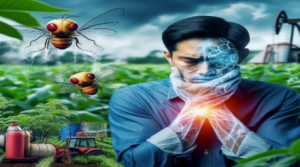
2. Chronic Health Effects
Long-term Exposure:
Chronic exposure to pesticides, even at low levels, can lead to long-term health issues such as endocrine disruption, reproductive problems, and developmental delays ni children.
Cancer:
Certain pesticides have been classified as carcinogens and are linked to an increased risk of cancers, including leukemia, lymphoma, and tumors of the brain, breast, prostate, and liver.
3. Neurological Disorders
Nervous System Damage:
Some pesticides, particularly organophosphates and carbamates, can affect the nervous system, leading to neurological disorders such as Parkinson’s disease, Alzheimer’s disease, and other
cognitive impairments.
4. Respiratory Issues
Respiratory Diseases:
Inhalation of pesticide fumes or dust can lead to respiratory problems like asthma, chronic bronchitis, and other lung diseases.
5. Endocrine Disruption Hormonal Imbalance:
Certain pesticides act as endocrine disruptors, interfering with hormone function. This can affect growth, development, and reproductive health, leading to conditions such as infertility, birth
defects, and developmental disorders.
6. Reproductive and Developmental Effects
Reproductive Health:
Pesticides can negatively impact reproductive health, causing issues such as reduced fertility, miscarriages, and birth defects.
Child Development:
Exposure to pesticides during pregnancy or early childhood can lead to developmental delays, learning disabilities, and behavioral problems.
7. Immune System Suppression Reduced Immunity:
Some pesticides can weaken the immune system, making individuals more susceptible to infections and diseases.
Exposure Pathways Direct Contact:
Handling and applying pesticides without proper protective equipment can lead to direct skin and eye contact, inhalation, and ingestion.
Residues on Food:
Pesticide residues can remain on fruits, vegetables, and grains, posing ingestion risks to consumers.
Environmental Contamination:
Pesticides can contaminate air, water, and soil, leading to indirect exposure through drinking water, bathing, and living in contaminated areas.
Pesticide Resistance
Causes of Pesticide Resistance .
1 Genetic Variation:
in any pest population, there is natural genetic variation. Some individuals may have mutations With that confer resistance to a particular pesticide. These individuals survive pesticide application and pass on their resistant traits to offspring.
2. Selection Pressure:
When a pesticide is applied, it kills the susceptible individuals but allows resistant ones to
and reproduce. Overtime, the proportion of resistant individuals in the population increases, leading to a resistant population.
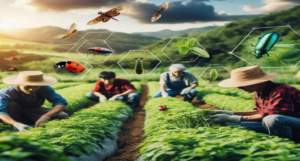
3. Overuse and Misuse of Pesticides:
Frequent and repeated use of the same pesticide increases the selection pressure for resistance. Inappropriate dosages and improper application methods can also contribute to resistance
development.
Types of Resistance
1. Behavioral Resistance:
Changes in the behavior of pests that allow them to avoid contact with the pesticide. For example, some insects may avoid treated areas or change their feeding habits.
2. Biochemical Resistance:
The pest produces more of an enzyme that breaks down the pesticide or changes the pesticide’s target site within the pest so that it no longer binds effectively.
3. Physiological Resistance:
Changes in the pest’s physiology, such as reduced absorption or increased excretion of the pesticide.
4. Pollinator Decline:
1. Agricultural Productivity:
Pollinators are essential for the pollination of many crops, contributing to higher yields and better-
quality produce. They are responsible for the production of about one-third of the food we consume.
2. Biodiversity:
Pollinators support the reproduction of many wild plants, maintaining biodiversity and healthy ecosystems.
3. Economic Value:
Pollination services provided by insects, particularly bees, have a substantial economic value, estimated in billions of dollars annually.
Effects of Pesticides on Pollinators
1.Toxicity:
Many pesticides, especially insecticides like neonicotinoids, are toxic to pollinators. They can cause direct mortality or sub-lethal effects such as disorientation, impaired foraging, and reduced
reproductive success.
2. Habitat Loss and Fragmentation:
Pesticides can degrade habitats by killing plants and insects that pollinators rely on for food and nesting sites.
3. Indirect Effects:
The reduction of food resources and nesting habitats due to pesticide use can lead to weakened pollinator populations.
4. Synergistic Effects:
The combined impact of pesticides with other stressors, such as disease, parasites, and habitat destruction, can exacerbate the decline of pollinator populations.
5. Impact of Pesticides on Soil Health
1. Disruption of Soil Microbial Communities Microbial Diversity:
Pesticides can reduce the diversity and abundance of soil microorganisms, including bacteria, fungi,
and protozoa. These microorganisms play crucial roles in nutrient cycling, organic matter decomposition, and soil structure maintenance.
Microbial Activity:
Certain pesticides can inhibit the metabolic activities of soil microbes, leading to reduced rates of processes such as nitrogen fixation, nitrification, and decomposition. This can affect nutrient availability for plants.
2. Soil Fertility and Nutrient Cycling Nutrient Availability:
The disruption of microbial communities can impact the soil’s ability to cycle nutrients. For example, beneficial fungi like mycorrhizae, which aid in nutrient uptake, can be adversely affected, leading to lower nutrient availability for crops.
Organic Matter Decomposition:
Pesticides can slowdown the decomposition of organic matter by affecting decomposer organisms. This can lead to the accumulation of undecomposed organic material and a
reduction in soil organic matter content, impacting soil fertility.
3. Soil Structure and Erosion
Soil Aggregation:
Healthy soil structure depends on the activities of microorganisms and soil fauna, which help form soil aggregates. Pesticides that harm these organisms can lead to poorer soil
structure, increasing susceptibility to erosion.
Soil Erosion:
With weakened soil structure, the soil becomes more prone to erosion by wind and water. Erosion not only removes the topsoil but also the nutrients and organic matter essential
for plant growth.
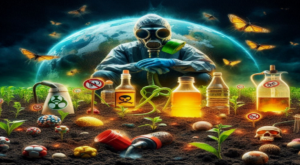
4. Soil Contamination Pesticide Residues:
Persistent pesticides can remain in the soil for extended periods, leading to long-term
contamination. These residues can affectsoil organisms, plant health, and even enter the food chain.
Leaching and Runoff:
Pesticides can leach into groundwater or runoff into surface waters, leading to contamination of water sources. This not only affects soil health but also poses risks to human and animal health.
5. Development of Resistant Soil Pathogens
Resistance Development:
Overuse of fungicides and bactericides can lead to the development of resistant soil pathogens.
These resistant strains can be more difficult to control and may require the use of even more potent chemicals, further exacerbating soil health issues.
6. Impact on Soil Fauna
Beneficial Soil Fauna:
Pesticides can harm beneficial soil fauna, such as earthworms, ants, and other invertebrates, that are essential for maintaining soil structure, aeration, and nutrient cycling.
Reduced Biodiversity:
A decline in soil fauna diversity can lead to imbalances in soil ecosystems, reducing the resilience of soil to environmental stressors and its ability to support healthy plant growth.
Integrated Pest Management (IPM):
To mitigate the negative impacts of pesticides, Integrated Pest Management (IPM) strategies are
promoted. IPM combines biological, cultural, mechanical, and chemical methods to manage pests ni an environmentally and economically sustainable way. Key practices include:
Crop Rotation:
Reducing pest buildup by rotating crops with different pest-resistant traits. Biological Control: Using natural predators or parasites to control pest populations.
Cultural Practices:
Implementing agricultural practices that reduce pest establishment, reproduction, and survival.
Selective Pesticide Use:
Applying pesticides in a targeted and judicious manner, only when necessary and using the least harmful options available.
Overall, while pesticides are essential for modern agriculture, their use needs to be carefully managed to minimize adverse effects on human health and the environment.
Conclusion
While pesticides area crucial tool in modern agriculture, their use must be balanced with strategies
to mitigate their negative impacts. Sustainable practices, such as IPM, can help
protect the environment and human health while maintaining agricultural productivity.
If you like this blog visit our other blogs –

